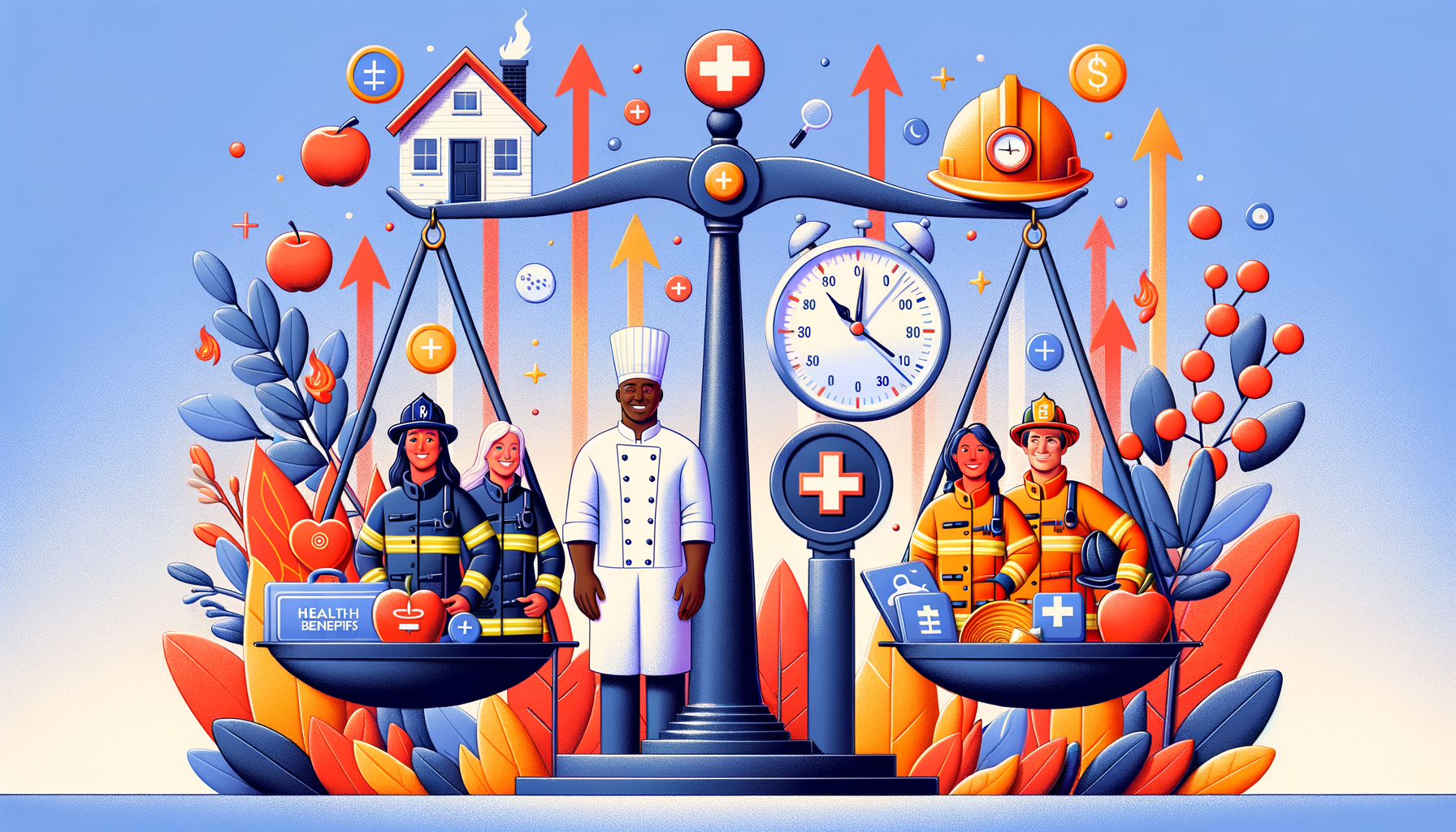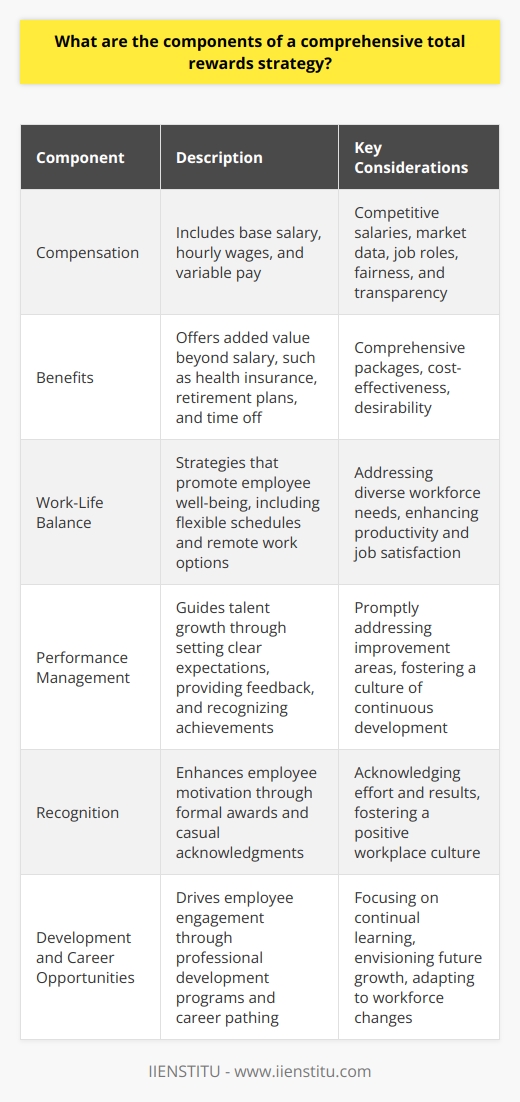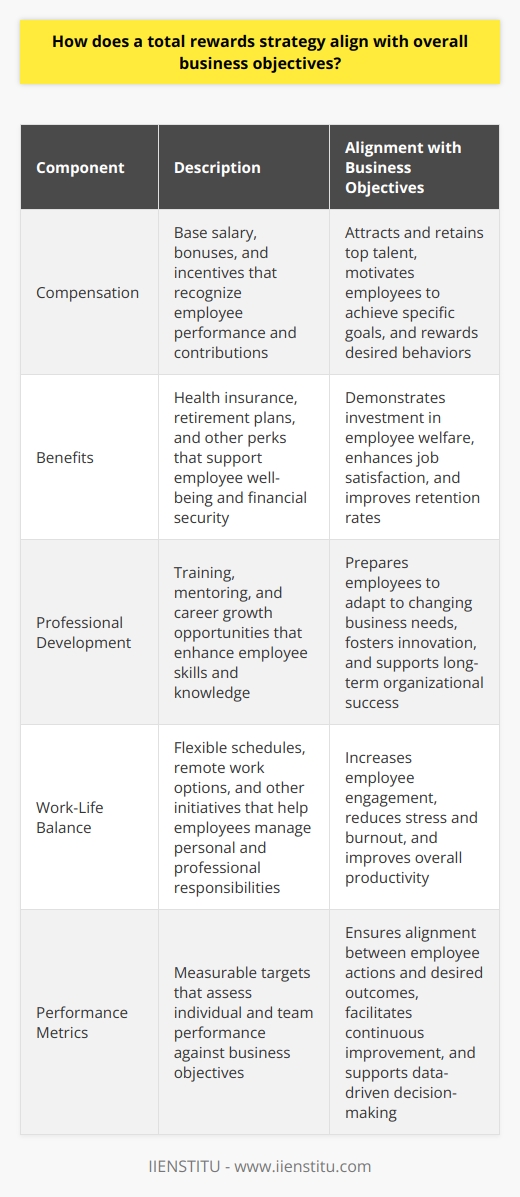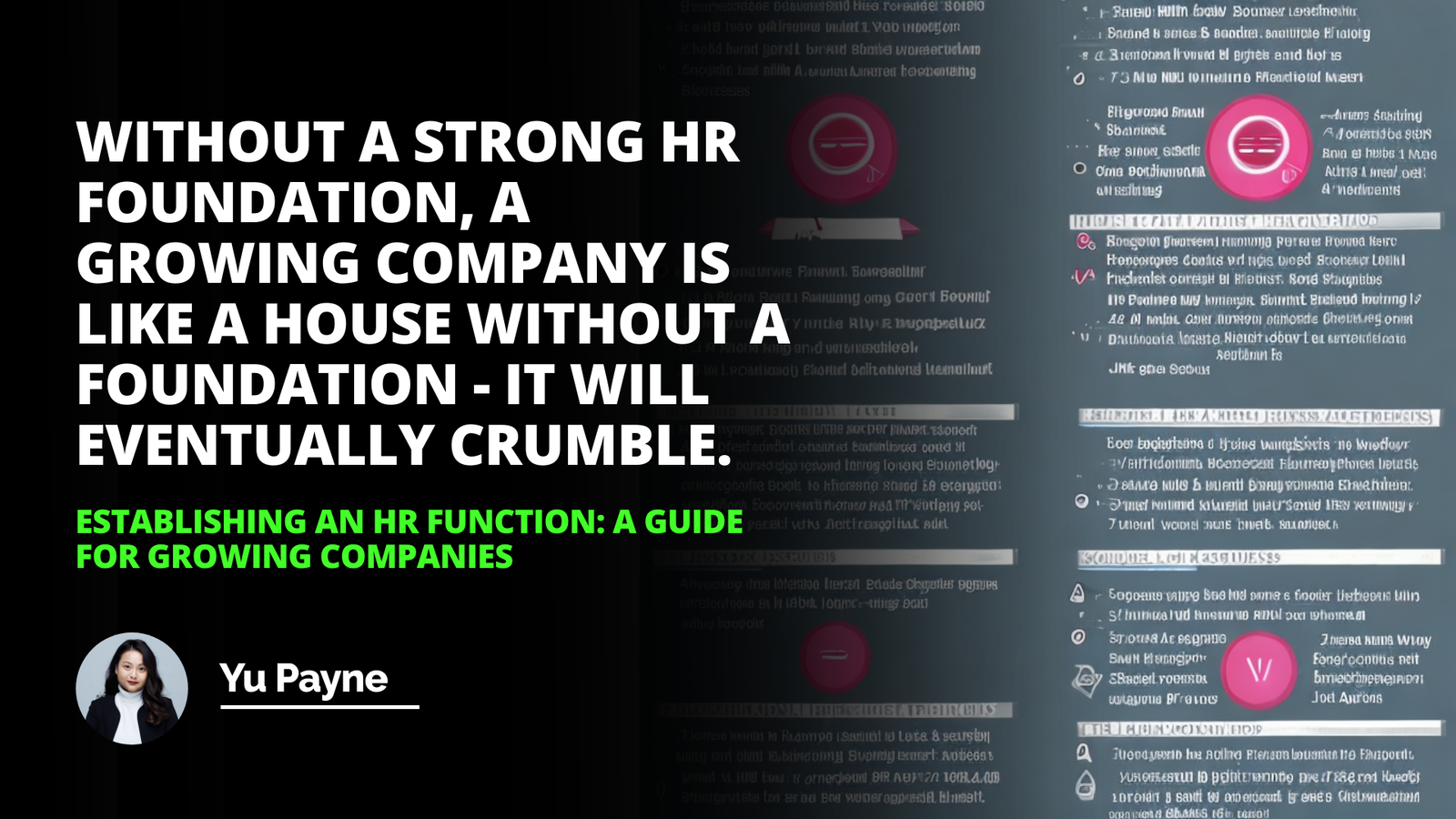
Total rewards encompass a holistic package designed to attract, motivate, and retain employees, an essential part of any organization's human resources strategy. In the ever-changing landscape of work, these rewards now go far beyond just financial remuneration, tapping into various human aspiration levels that align personal goals with organizational objectives.
This article scrutinizes every facet of the total rewards system, emphasizing why, more than ever, a comprehensive understanding and sophisticated implementation of this concept is indispensable for any company's longevity and prosperity.
🔊 Ready for an auditory reading experience? Just click the 'Play' button right below this text and immerse yourself in our captivating audio version. Ideal for those who prefer listening to stories, or for times when you're multitasking. Engage with our content effortlessly - one simple click is all it takes to transform your reading into listening!
Introduction to Total Rewards Concept
The concept of total rewards extends a more granular framework that supplants the traditional view of employee compensation. Under this paradigm, total rewards are considered the inclusive set of tools available to an employer that may be leveraged to attract, motivate, and retain employees. This approach addresses the diverse needs of the workforce and acknowledges the varied preferences that different employees may have depending on their lifecycle stage, lifestyle, and career ambitions.
Understanding the total rewards concept is quintessential for those aspiring to acquire a human resources certification. It equips HR professionals with the tools to create compelling value propositions for current and prospective employees. This approach is integral because it's not just about monetary gain but encompasses recognition, opportunities for advancement, and the delicate balance of work and life.
The impact of total rewards on employee motivation and productivity cannot be understated. A well-constructed rewards system is indicative of how much an organization values its workforce, potentially leading to increased employee satisfaction, lower turnover rates, and higher performance levels. The rich tapestry of employee rewards extends beyond the desk, influencing the quality of life and workplace harmony.
The Five Elements of Total Rewards
The versatility of the total rewards framework is structured around five key elements: Compensation, Benefits, Work-life flexibility, Performance and recognition, and Development and career opportunities. Each element functions not in isolation but as an interrelated component of a comprehensive package that acknowledges employees' multifaceted needs and desires.
Each of the five facets plays a crucial role in employee administration. By carefully calibrating each element, HR professionals can craft a more appealing and compelling suite of rewards. Such a move can significantly enhance the organization's ability to attract top talent, provide sufficient incentives for employee retention, and stimulate motivation throughout the workforce, thus fostering a culture of excellence and commitment.
The Corporate HR Imperative: Achieving Total Quality Management
Variable Pay: An In-depth Look at Modern Compensation Strategies
Compensation Aspect of Total Rewards
In the realm of total rewards, compensation refers to the financial returns employees receive for their labor—including their salary, wages, bonuses, commissions, and any other monetary benefits. This is often the most immediate concern for employees and typically the most significant investment for employers.
Different types of compensation serve different purposes. Base pay, for example, offers a reliable income, whereas incentives such as bonuses are typically tied to performance or company profitability. From an organizational perspective, how compensation is structured can have far-reaching consequences for talent acquisition and retention.
A poignant case study illustrating compensation's role in total rewards might involve a technology startup that implements a competitive salary structure alongside profit-sharing schemes. This not only attracts skilled professionals and fosters a sense of ownership among employees but ensures that their personal gains are aligned with the company's growth, leading to increased dedication and innovation.
Benefits Aspect of Total Rewards
Benefits are non-wage compensations that complement the salary an employee receives. This component includes a variety of programs such as health insurance, retirement plans, and paid time off. To many employees, especially in today's highly health-conscious world, a robust benefits package can sometimes eclipse the importance of base pay.
The types of benefits offered can serve as a litmus test of an organization’s culture and values. Progressive companies might offer expansive paternity leave, mental health support, or comprehensive medical plans. These offerings advocate the company’s commitment to the holistic well-being of its employees.
For instance, a global corporation that provides extensive health coverage, flexible remote work options, and unlimited leave policies can set a standard and act as an archetype in the benefits spectrum. This not only enhances its reputation as a trailblazing employer but also demonstrates its investment in crafting a nurturing and supportive environment for its employees.
Work-Life Flexibility Aspect of Total Rewards
The modern workforce increasingly prioritizes work-life flexibility, which represents the balance an employee achieves between time allocated for work and other aspects of life. This equilibrium is becoming a pivotal factor in employee retention and satisfaction, with many seeking jobs that provide the flexibility to work remotely or on a schedule that fits their lifestyle.
Work-life flexibility can have a direct influence on employees mental health, general well-being, and work satisfaction. Progressive companies that facilitate remote work, flexible hours, and time-off for personal development are often held in high regard and thereby attract quality candidates.
An example of a company promoting work-life balance is one that not only permits telecommuting but also actively encourages its employees to engage in activities outside of work. Such a company might sponsor team sports events or offer sabbaticals for personal projects, making it not just a place of employment, but a nurturing community.
Performance and Recognition Aspect of Total Rewards
Recognition is a powerful motivator and, when tied to performance, it can have a profound effect on an employees sense of value and commitment to their job. In the context of total rewards, this acknowledgment comes through formal and informal channels.
A robust performance and recognition system invites transparency and encourages a meritocratic culture. Incorporating recognition programs where employees are celebrated for their achievements can stimulate a sense of ownership and pride in their work, and in turn, enhance their engagement and loyalty to the company.
In a striking scenario, a company with a finely-tuned system of recognizing employee achievements, whether through awards, promotions, or public acknowledgments, can provide a compelling case study on the tangible benefits recognition brings not only to individual employee morale but also to workplace camaraderie and overall company performance.
Development and Career Opportunities Aspect of Total Rewards
For many employees, access to development and career advancement opportunities is as valuable as monetary compensation. Professional growth is a key driver for job satisfaction, and when organizations invest in their employees futures, they cultivate a motivated and forward-thinking workforce.
In the framework of total rewards, these opportunities can include professional development courses, educational assistance, mentorship programs, and clear pathways for career progression. Such benefits demonstrate the organization’s commitment to the individual's growth and recognition of their potential.
A compelling case study might showcase an organization that has invested heavily in employee development programs, offering online courses with certificates, opportunities for internal movement, and leadership training. The success story would reveal a high retention rate and a pool of employees ready to ascend the leadership ladder, testifying to the significance of career development in the total rewards equation.
Challenges and Solutions in Implementing Total Rewards
While the total rewards approach provides a robust framework for employee compensation, its implementation is not without challenges. These may include budgetary constraints, cultural barriers within the organization, and complexity in administering such a comprehensive system.
Organizations seeking to overcome these hurdles can employ several strategies such as leveraging technology for program management, communication to illustrate the value of the total rewards package, and ongoing analysis to ensure the rewards remain relevant and competitive. As part of a dynamic human resources certification program, professionals are equipped with the expertise to navigate and apply these solutions effectively.
The Role of Total Rewards in the Future of Work
As the concept of work itself evolves, the role of total rewards will undoubtedly adjust in tandem. The shift towards more flexible working arrangements, a greater focus on mental health and well-being, and the rise of the gig economy are all factors that will shape the development of total rewards strategies.
In the future, total rewards may include elements we have not yet considered, responding to the needs and desires of a new generation of workers. It's crucial for HR professionals to stay ahead of these shifts, readily adapting to an evolving job market. Ultimately, the success of an organization hinges significantly on its ability to offer an effective total rewards strategy that resonates with the wants and needs of its employees, today and tomorrow.
Best Practices for Implementing Total Rewards Strategy
To implement an effective total rewards strategy, it is recommended that organizations undertake thorough benchmarking to comprehend industry standards, foster transparency with employees on the value of the rewards offered, and implement programs that are flexible enough to cater to a diverse workforce.
By conducting regular evaluations, employers can gather feedback and tailor their offerings to better suit employee needs. In this way, an effective total rewards program not only aids in recruitment and retention but also serves as a reflection of the organization's principles and culture.
Changes and Predictions for Total Rewards
The last few decades have seen significant changes in the makeup of total rewards; for instance, the emphasis on work-life balance has become increasingly pronounced. As we look to the future, it is likely that personalization, technology, and a greater focus on non-traditional rewards will remain consistent themes.
As technology advances and the nature of jobs changes, online courses with certificates, remote working provisions, and virtual health services might become standard components of the total rewards package. Predicting such trends is crucial for future-proofing an organization’s HR strategy and ensuring its resilience in an ever-competitive landscape.
In conclusion, the application of an effective total rewards strategy is crucial for the success of any organization. By recognizing the evolving landscape of employee expectations and the diverse aspects of compensation beyond just salary, companies can build a strong foundation for employee satisfaction, engagement, and retention. As we look to the future, the dynamic nature of the workforce will necessitate a continuous review and refresh of total rewards systems, ensuring that they remain relevant, equitable, and motivating for the employees, the very backbone of an organization's success.
Frequently Asked Questions
What are the components of a comprehensive total rewards strategy?
Understanding Total Rewards Strategy
A total rewards strategy encompasses numerous components. These elements strive to attract, motivate, and retain employees. They support business goals and employee satisfaction. Each component plays a crucial role.
Compensation
Compensation stands as a core element. It includes base salary, hourly wages, and variable pay. Employers must ensure competitive salaries. They look at market data and job roles. Fairness and transparency remain important.
Benefits
Benefits offer added value beyond salary. They include health insurance, retirement plans, and time off. Employees seek comprehensive benefits packages. Employers aim for cost-effective, desirable options.
Work-Life Balance
Strategies around work-life balance have grown in importance. They include flexible schedules and remote work options. Work-life programs promote employee well-being. They address diverse workforce needs.
Performance Management
Performance management guides talent growth. It involves setting clear expectations and feedback. Recognizing achievements is crucial. Improvement areas get addressed promptly.
Recognition
Recognition enhances employee motivation. It ranges from formal awards to casual thanks. Recognition acknowledges effort and results. It fosters a positive workplace culture.
Development and Career Opportunities
Growth opportunities drive employee engagement. Professional development programs are key. Career pathing helps employees envision their future. Employers focus on continual learning and progression.
The Workplace Environment
The workplace environment affects morale and productivity. It should be safe, inclusive, and supportive. Employers invest in ergonomic and collaborative spaces. They prioritize a positive company culture.
To conclude, a comprehensive total rewards strategy requires balancing these components. Employers must adapt to workforce changes. Employees' needs should guide strategy refinement. A thoughtful approach yields organizational success.

How does a total rewards strategy align with overall business objectives?
Aligning Total Rewards with Business Objectives
Total rewards encompass various elements. They include compensation, benefits, professional development, and work-life balance. A total rewards strategy must align with business objectives. It incentivizes behaviors that achieve those objectives.
Understanding Business Objectives
Business objectives vary greatly. Common goals include profitability, growth, and market share. Others may focus on innovation, customer satisfaction, or sustainability. Each goal requires specific employee actions. Reward strategies encourage these actions.
Components of Total Rewards
Let's break down the total rewards components. They are not just about salary. There's more.
Compensation: This is the base salary or hourly wage. Performance bonuses may also apply. Both must be competitive to attract talent.
Benefits: These include health insurance, retirement plans, and paid time off. They secure employee well-being.
Professional Development: Opportunities for growth and advancement fall here. They ensure a competent, evolving workforce.
Work-Life Balance: Flexible hours and remote work options are examples. They attract and retain a diverse workforce.
Aligning Strategy with Objectives
Alignment requires strategic thinking. A business pursuing innovation might emphasize professional development. This ensures an adaptive, skilled workforce. An emphasis on customer satisfaction might lead to rewards linked to service metrics. These metrics encourage a customer-first mindset.
Measuring Success
Metrics are crucial. They track alignment success. Improved employee performance often results. Greater job satisfaction and reduced turnover might occur as well.
Adapting to Change
Business needs evolve. Total rewards strategies must remain flexible. Adjustments keep them relevant and effective.
In sum, total rewards strategies must reflect business objectives. Such strategies ensure employee behavior aligns with desired outcomes. Effective strategies result in a synchronized organization. They support business success.

What are the long-term implications of implementing a comprehensive total rewards strategy for employee retention and performance?
Understanding Total Rewards
A comprehensive total rewards strategy encompasses various facets of employee compensation and benefits. It considers wages, bonuses, benefits, and non-monetary perks. Such a strategy stands as a holistic approach to recognizing and rewarding employees’ contributions.
Implications for Employee Retention
Total rewards have significant implications for employee retention. Employees often look beyond salary when choosing where to work. They seek meaningful recognition and a balance between work and life. A thoughtfully crafted total rewards strategy can meet these needs.
Job Satisfaction Enhancement
Rewards elevate job satisfaction.
Employees feel valued.
This satisfaction fosters loyalty.
Reduced Turnover
Employees are less likely to leave.
Costs of turnover diminish.
Investment in employees pays off long term.
Performance Impact
Performance links closely with rewards. Total rewards strategies can enhance employee motivation and engagement.
Boosts in Productivity
Motivated employees are more productive.
Quality of work may improve.
Business operations can see efficiency gains.
Nurturing Talent
Rewards can attract top talent.
They retain high-performing individuals.
This nurtures a competitive workforce.
Broad Organizational Benefits
A total rewards approach affects more than individual employees. It has wide-reaching benefits across the organization.
Culture and Reputation Advancements
A rewards strategy enhances company culture.
It positions the company favorably in the market.
Employer branding can attract superior candidates.
Financial Health
Happy employees contribute to a healthier bottom line.
Retained talent saves on rehiring costs.
Performance gains can drive profitability.
Sustainability of the Strategy
Sustainability of total rewards is critical. Organizations must ensure their rewards strategies remain relevant and competitive.
Continual Investment
Employers must invest in their workforce consistently.
Rewards strategies require updates and adaptations.
Employee needs change over time.
Measurement and Adjustment
The impact of rewards strategies needs measurement.
Regular reviews maintain strategy effectiveness.
Adjustments are necessary in response to feedback.
Understanding and implementing a comprehensive total rewards strategy has far-reaching implications. It influences employee retention, performance, and the broader organizational health. With consistent investment and adaptation, such a strategy can provide sustainable benefits to both employees and the company as a whole.



